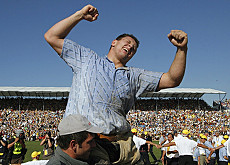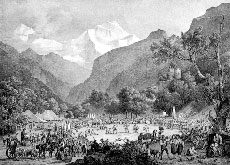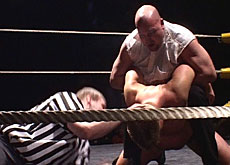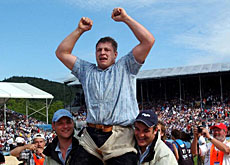Big strong men fight in the sawdust

Practitioners of the ancient art of "Schwingen", traditional Swiss wrestling, have been fighting it out in Aarau to take home the crown of the country's best wrestler.
It was finally Jörg Abderhalden who took the honours on Sunday for the third time at the Federal Wrestling Festival, but his win was overshadowed by the sudden death of one of the competitors the day before.
It’s hard to find an event with more tradition in Switzerland. The festival started early on Saturday, the athletes entering the arena under a blue sky and to the sound of the national anthem.
But some of the festive atmosphere was gone by the afternoon, when the organisers announced that one of the competitors had died of a heart attack. The 28-year-old man had felt pain in his chest between two rounds of fighting and passed away at a local clinic.
This didn’t stop 200,000 wrestling fans from turning up over the weekend. They are for the most part traditionalists and would not miss the festival – which only takes place every three years – for anything. Many arrived on Friday to be sure they could take in all the action.
Abderhalden gave them value for money in the final. Sitting behind Stefan Fausch on points before their bout, he was able to pin down his adversary after eight minutes and retain his crown.
Among the spectators were a few recognisable faces, such as former Cabinet minister Adolf Ogi – the outgoing United Nations special representative for sport and peace – and Swiss Economics Minister Doris Leuthard, who comes from the region.
But the Swiss president didn’t make an appearance. Micheline Calmy-Rey decided not to give the traditional speech, leaving the job to Sport Minister Samuel Schmid.
Strong men
Schwingen is a competition for big – read “real” – men.
The meal of choice is a big veal sausage, washed down if possible with a big beer. To keep up with demand, the country’s biggest brewery has supplied 600,000 bottles of its finest for the festival.
Swiss television is out in force, bringing some high-tech flair to the proceedings. A camera hovers on cables above the sawdust rings, offering a bird’s-eye view of the action.
“People’s reactions show that they have a thirst for tradition and want to get in touch with their roots,” said the president of the organising committee, Rainer Huber.
Huber, who is a member of canton Aargau’s government, told swissinfo that he considered the festival a “significant event of national importance”.
Tradition
Hans Pauli, president of the national Schwingen association puts all this goodwill down to society’s “unfailing” recognition of the sport. He admits though that not everyone might not be as interested in Switzerland’s homegrown wrestling as he is.
“In [Italian-speaking canton] Ticino, there are no wrestlers, and only 20 per cent come from French-speaking areas,” he told swissinfo.
And strangely enough in this day and age of professional sports, Schwingen is strictly for amateurs. The winner in Aarau will take home the glory and a bull, while the also-rans will get cows, horses and assorted gifts, which include cow bells.
The prizes reflect the tradition of Swiss wrestling mainly practised in former times by farmers and cowherds.
Today, the men are still built like mountains, but are not necessarily from the mountains. Chances are one of these athletes could be one of your neighbours – a butcher, a baker or a candlestick maker.
Only one thing stays the same. “The rules have not changed for hundreds of years,” said Pauli. “It’s just the backdrop that is different nowadays.”
swissinfo, Andreas Keiser in Aarau
In Schwingen, the fight takes place on a circular area with a diameter of 12 metres covered with sawdust.
The two opponents wear loose shorts over their clothes. The fighters grab hold of each other’s shorts and try to throw their opponent onto their backs.
A fight is won when the winner holds the opponent’s shorts with at least one hand and both the opponent’s shoulders touch the ground.
There are three judges who give points for each fight. If it ends without a clear winner, the more active fighter is awarded the most points.
At the federal festival, every wrestler fights up to eight opponents. The two athletes with the most points after seven rounds are admitted to the final.
The Federal Wrestling and Alpine Games Festival is the most prestigious event for Swiss-style wrestling.
It is also an important competition for those who champion other unique Swiss sports – Hornussen and throwing of the Unspunnen Stone.
The event attracts the best yodellers, flag-throwers and alphorn players in Switzerland as well.
The festival is held only once every three years, moving to a different region of Switzerland each time.

In compliance with the JTI standards
More: SWI swissinfo.ch certified by the Journalism Trust Initiative



You can find an overview of ongoing debates with our journalists here. Please join us!
If you want to start a conversation about a topic raised in this article or want to report factual errors, email us at english@swissinfo.ch.